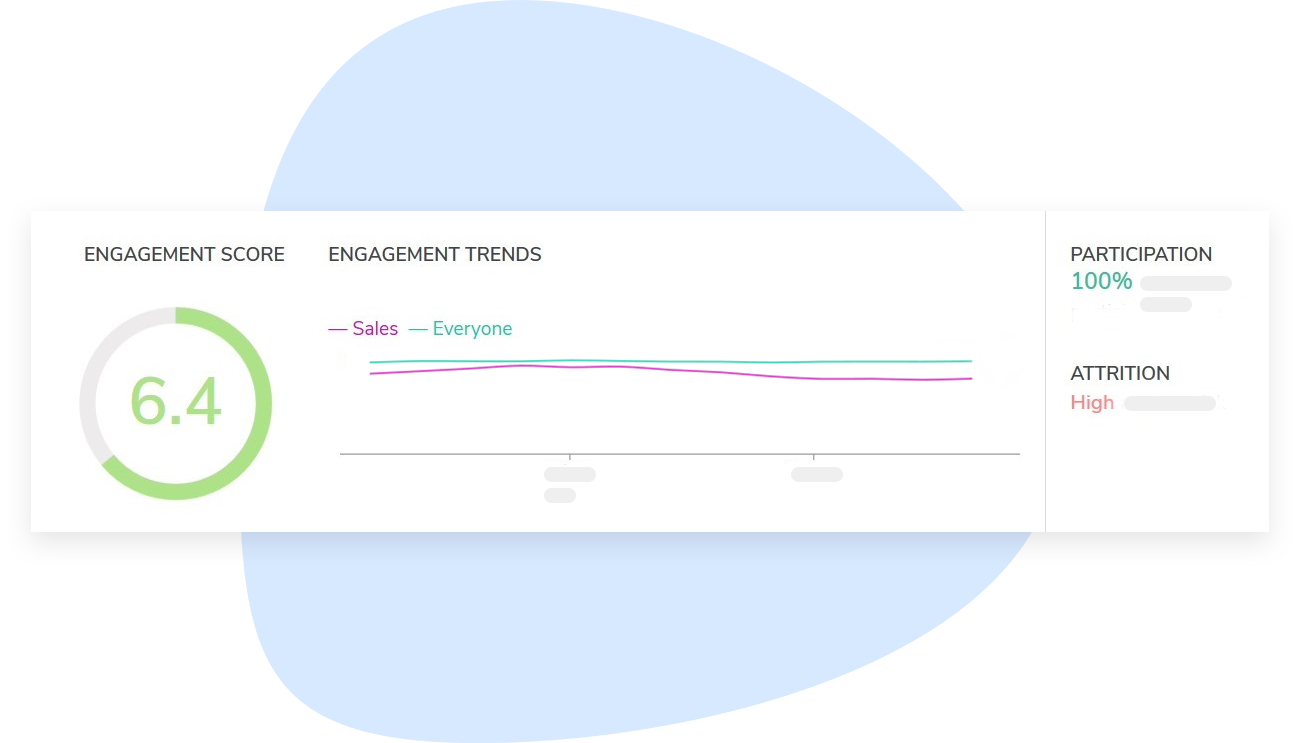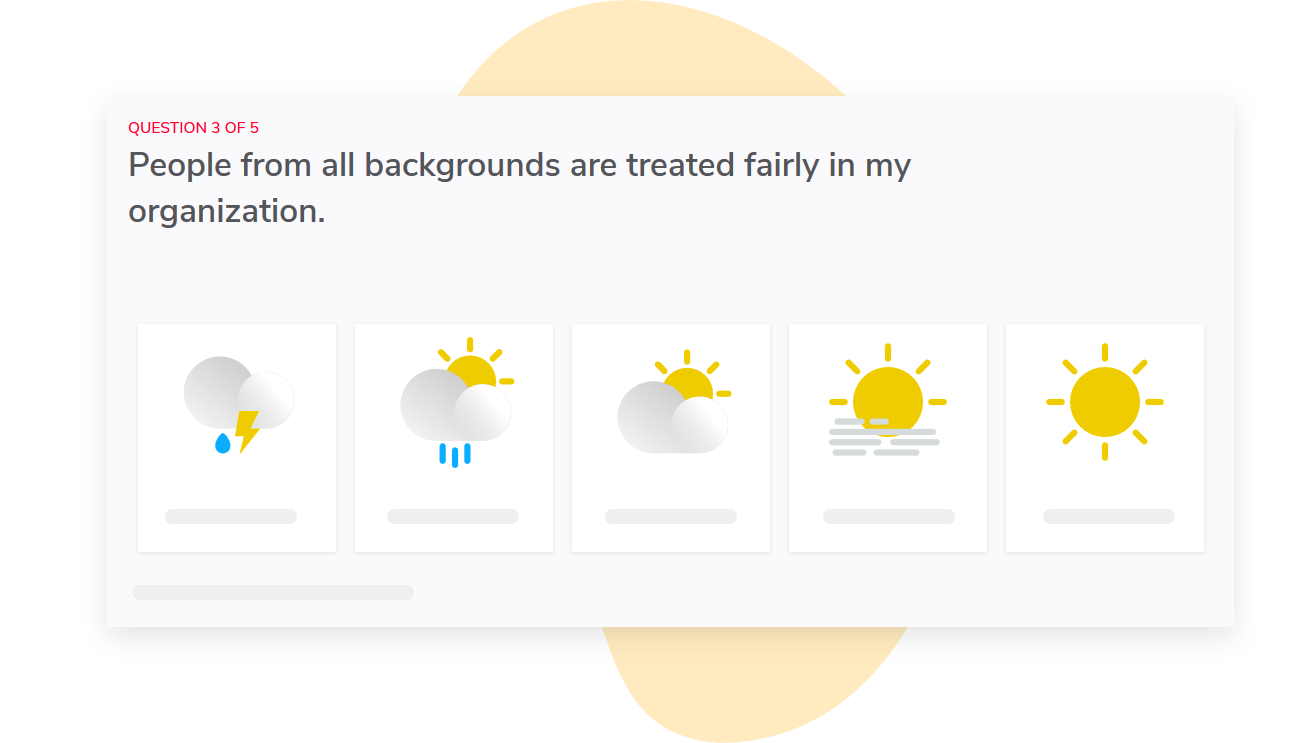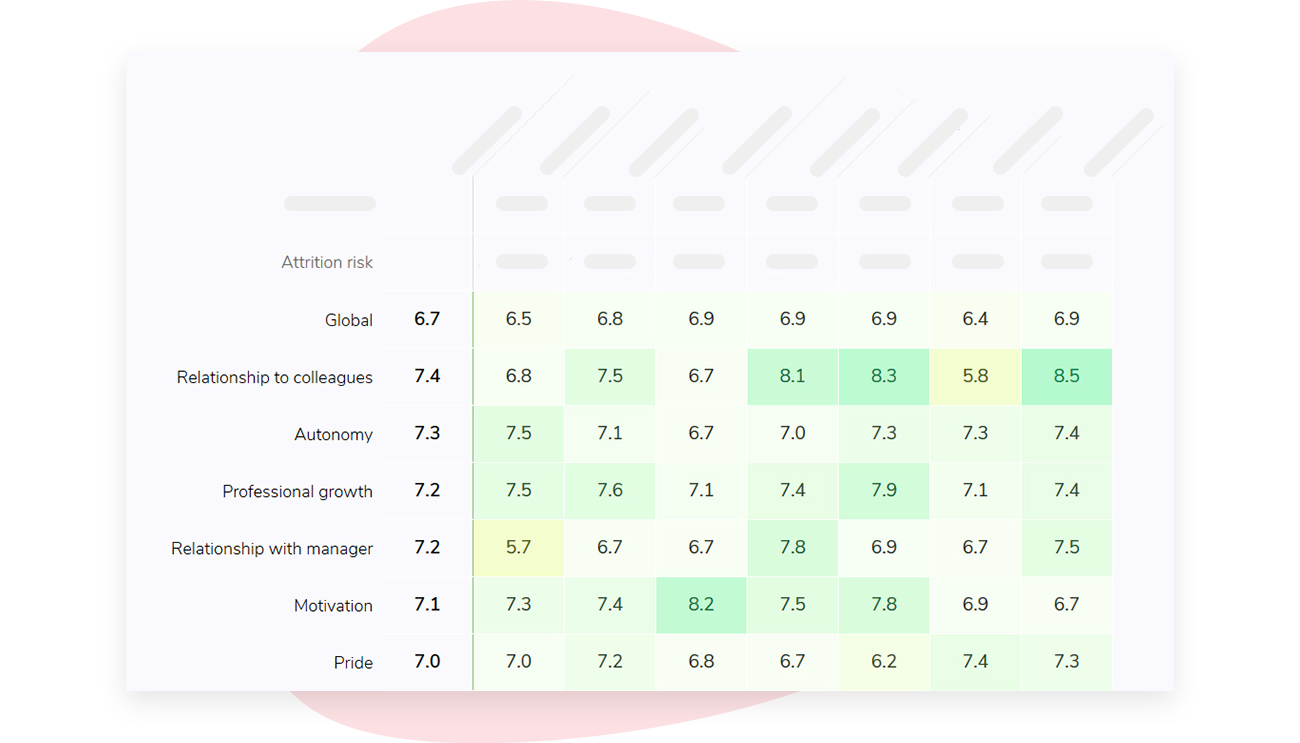员工脉搏调查工具
通过 Sparkbay 的脉搏调查软件获取准确且频繁的员工反馈
员工投入驱动企业发展。 Sparkbay 监控员工参与度,提醒任何脱离参与的迹象,助力您通过数据驱动建议改进。
我们的脉搏调查工具如何提升员工参与度
实时洞察
Sparkbay收集您组织中每位员工的反馈。
与传统调查不同,Sparkbay 的脉冲调查只需几分钟即可完成,且能即时提供数据。

提出正确的问题
通过智能问题分配,Sparkbay能在合适的时间向合适的人提出合适的问题。 这样,您能在员工敬业度下降的早期阶段及时发现。

做出数据驱动的决策
做出正确的决策对您的成功至关重要。
Sparkbay的交互式仪表板将为您的领导层提供针对每个员工群体的可操作洞察: 直接经理、部门、办公室、任期、职位、人口统计等。

根据反馈采取行动:闭环管理
收集员工反馈只是开始。
Sparkbay 让您的管理者成为团队中的变革推动者,提供个性化可操作建议。

提升员工敬业度
实地查看Employee pulse surveys FAQ
What is a pulse survey tool?
A pulse survey tool is a digital platform designed for the swift collection, analysis, and reporting of employee feedback on various aspects of their work life. It includes job satisfaction, engagement, and organizational culture.
Unlike traditional, lengthy annual surveys, pulse surveys are concise, enabling frequent administration to capture timely insights into employee sentiment. This approach facilitates agile decision-making by providing ongoing, actionable data that reflects the dynamic nature of employee experiences, thereby allowing organizations to promptly identify and address issues, as well as leverage opportunities to enhance workplace satisfaction and productivity.
Why use a pulse survey tool?
Organizations deploy pulse survey tools for several strategic reasons:
- Real-time feedback: They offer a mechanism for continuous listening, enabling the capture of immediate employee perceptions and experiences.
- Improved engagement and communication: Regular interaction through surveys signals to employees that their opinions are valued, fostering a culture of openness and reinforcing trust in leadership.
- Increased insights: Frequent feedback provides a rich data set for identifying trends, predicting potential issues, and understanding the impact of changes within the organization.
- Better decision-making: Insights from pulse surveys empower leaders to make evidence-based decisions that can positively influence the organizational climate and employee morale.
- Cost-effective: These tools offer a scalable and efficient solution for gathering insights without the logistical complexity and higher costs associated with traditional survey methods.
Thus, pulse surveys are an integral component of a proactive human resources strategy, enabling organizations to stay closely connected with their workforce dynamics and improve the overall employee experience.
What are the key features of an employee pulse survey tool?
Essential attributes of an effective pulse survey tool encompass:
- Ease of use: Intuitive design for both administrators and respondents to facilitate seamless survey creation, distribution, and completion.
- Customization: Flexibility to tailor questions and branding to align with specific organizational goals and culture.
- Real-time reporting: Advanced analytics capabilities for immediate insights, enabling quick action on feedback.
- Data security: Robust security protocols to protect confidential information and ensure compliance with data protection regulations.
- Multi-channel distribution: Versatility in delivering surveys through various channels to maximize reach and response rates.
- Integration with other tools: Seamless connection with HRIS and other business systems for holistic management of employee data.
- Automated notifications: Alerts and reminders to engage participants and stakeholders throughout the survey process.
- Responsive design: Compatibility with a wide range of devices to ensure accessibility for all employees.
Collectively, these features underpin a pulse survey tool's ability to gather meaningful feedback efficiently, thereby supporting informed, strategic decisions that enhance employee engagement and organizational performance.
What is an employee pulse survey?
An employee pulse survey is a strategic tool employed by organizations to frequently assess and understand the evolving sentiments and engagement levels of employees. It consists of concise, focused questions designed to capture a snapshot of employee feelings and perceptions at regular intervals.
This continuous, quick-feedback mechanism allows management to gauge the health of the organization, identify areas of concern, and address them proactively. Pulse surveys are distinguished by their brevity, frequency, and agility, enabling organizations to make timely, informed decisions that contribute to a positive work environment and high employee engagement.
How do you create a pulse survey?
Creating a pulse survey involves strategic planning and execution. Begin by defining clear objectives and identifying the key areas of employee experience you wish to explore.
It is crucial to formulate questions that are concise, relevant, and easy to understand, ensuring they align with the survey’s goals. Consider employing a mix of quantitative and qualitative questions to gather both measurable data and open-ended responses for deeper insights.
Additionally, leveraging technology that supports customization, anonymity, and real-time analytics can significantly enhance the effectiveness of pulse surveys. Lastly, communicate the purpose and benefits of the survey to employees, emphasizing confidentiality to encourage honest and candid feedback.
How to encourage participation in the pulse survey?
Maximizing participation in pulse surveys requires a multifaceted approach. Start by clearly communicating the survey’s purpose and how the data will be used to make meaningful improvements.
Assuring participants of the anonymity and confidentiality of their responses can alleviate concerns about privacy and reprisal. It is also beneficial to streamline the survey process to minimize time and effort required by participants.
Following up with transparent reporting on survey outcomes and demonstrating tangible changes based on feedback can reinforce the value of participation, thereby fostering a culture of continuous feedback and engagement.
Are pulse surveys confidential?
Confidentiality is paramount in pulse surveys to ensure genuine, uninhibited employee feedback. These surveys are designed to aggregate data in a manner that preserves individual anonymity while providing insightful feedback on group or organizational trends.
By focusing on collective insights rather than individual responses, pulse surveys facilitate an environment where employees feel safe to express their true opinions. This approach supports a culture of trust and openness, allowing organizations to gain accurate reflections of employee sentiment and fostering a constructive dialogue for improvement.
What is a good employee survey response rate?
A robust response rate for an employee survey reflects high engagement and willingness to contribute to organizational improvement. While a 100% rate may be unrealistic and potentially indicative of compulsory participation, aiming for a 70-85% response rate is generally considered healthy, depending on organizational size and culture.
Smaller organizations may target the higher end of this range due to closer employee relationships, while larger organizations may find a 65-75% rate achievable and indicative of a strong participatory culture. Achieving and maintaining high response rates requires continuous effort in communicating the value of surveys, ensuring anonymity, and demonstrating that feedback leads to actionable changes.
How many questions should be in a Pulse survey?
The length of a pulse survey should balance the need for comprehensive insights with the desire for brevity to ensure high response rates. The optimal number of questions varies based on the survey’s frequency and objectives.
Generally, a bi-weekly survey might include 5 questions, a monthly survey 10 questions, and a quarterly survey up to 15 questions. This framework ensures that surveys remain concise and focused, minimizing respondent fatigue while providing valuable, actionable feedback.
What is the ideal pulse survey frequency?
Determining the ideal frequency for pulse surveys requires a thoughtful consideration of organizational dynamics and goals. Factors to weigh include the variability of the metrics being measured and the organization’s capacity to analyze and act upon feedback.
Typically, conducting surveys bi-weekly to quarterly strikes a balance between gathering timely feedback and allowing sufficient time for analysis and implementation of changes. This cadence can be adjusted based on specific organizational needs, ensuring that surveys remain a valuable tool for continuous improvement.
Are pulse surveys anonymous?
Ensuring anonymity in pulse surveys is critical for eliciting honest and meaningful feedback. By guaranteeing that individual responses cannot be traced back to the respondents, organizations encourage openness and transparency.
This anonymity is maintained through aggregated reporting, where results are presented in summary form without identifying individual participants. For smaller teams, setting a minimum response threshold before sharing results can further protect anonymity, thereby fostering a culture of trust and candid feedback.
